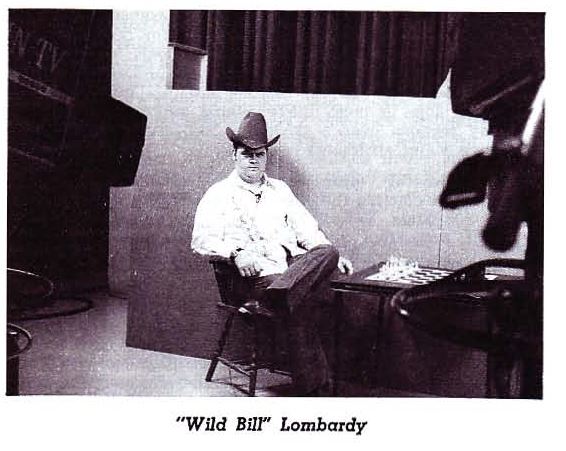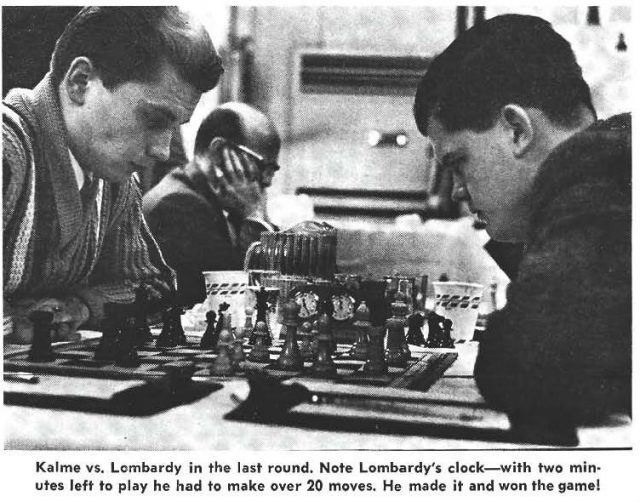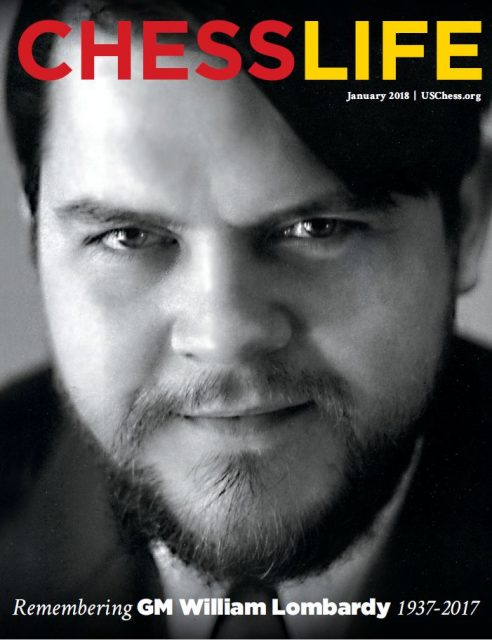
The attached lists of over 800 entries is a brief index for when William Lombardy was mentioned in
Chess Life between 1953 and 1975 and then between 2008 and 2017, and in
Chess Review from 1953-1969. This list was created from word-searchable PDFs of
Chess Life magazine issues. There are currently no PDFs available for the time between January 1976 and September of 2008.
Chess Life Magazine Lombardy Index (xls file)
Lombardy in Chess Life & Review (xls file)
The listing is focused on articles covering chess games that Lombardy played or analyzed. There are some primarily narrative articles that have also been included, usually with a brief explanation. Advertisements for books, listings in table of contents, and indexes have been excluded.
 Benko and Lombardy on the cover of Chess Life & Review in 1975
Benko and Lombardy on the cover of Chess Life & Review in 1975
Due to technical limitations, searched words can occasionally be missed. Even with that caveat, this reference will undoubtedly provide easier access to this historic content when examining Lombardy’s career.
From 1953 (when Lombardy was first mentioned) to the end of 1960
Chess Life was a newspaper that came out on the 5
th and 20
th of each month. The magazine generally covered the United States, but was very New York centric. There was even a Chess Life in New York column in every issue. Then in January 1961, under the guidance of Frank Brady, the newsletter became a monthly magazine with wider national coverage.

In 1969,
Chess Life bought the
Chess Review magazine, which had been owned and operated by A. I. Horowitz for many years. Starting in November 1969, the magazine was called
Chess Life & Review and the publication kept that name until 1980.
Electronic copies of issues since 2008 can be downloaded here.
Abbreviations:
- - A number inside of parentheses is in which round the game was played.
+=- - Results are often given as +2=3-1, for example. This means that Lombardy won two, drew three, lost one. +7=4 would be seven wins, four draws, and zero losses.
Person 1 Score Person 2 Opening Number of moves – This is the general method used for report games, for example: Lombardy 1- 0 Reshevsky Sicilian 36, means Lombardy was white and beat Reshevsky in 36 moves. This method of reporting games allowed for including the maximum amount of material with space constraints.
This game was found among the archived materials of John Collins at the University of Indiana. The game could easily have been included in the examples of Lombardy's fine play in the 1966 U.S. Open, where he finished second, the game would be listed: Lombardy 1-0 Clarke Caro-Kann 11.
[pgn]
[Event "US Open 1966"]
[Site "Seattle, Washington"]
[Round "?"]
[White "Lombardy, William"]
[Black "Clarke, Alan"]
[Result "1-0"]
[ECO "B11"]
[PlyCount "21"]
[EventDate "2017.??.??"]
1. e4 c6 2. Nc3 d5 3. Nf3 dxe4 4. Nxe4 Bf5 5. Ng3 Bg6 6. h4 h6 7. Ne5 Bh7 8.
Qh5 g6 9. Qf3 Qd5 10. Qxd5 cxd5 11. Bb5+ 1-0
[/pgn]
Person 1 = Player playing white
Score 1 – 0 white wins; ½ draw; 0-1 black wins
Person 2 – Player playing black
Opening – Opening given by the article, usually very generic
Number of moves – this number after the opening is the number of moves. A plus sign at the end means that the game continued for an unspecified number of moves – i.e. and black won a few moves later or and the rest is a matter of technique.

Note on page numbers: If it was a large article with a brief Lombardy reference, the article pages are given then a comma and then the page Lombardy appears on, such as 19-25, 25.
With this reference post, the two parts of my work
(please see the article on Lombardy in January 2018 Chess Life) have been completed. This work could not have been accomplished without the help of over fifty people. Some are world famous (at least in the chess world) others are known only locally, but I benefited from the help of all of them. The person who helped the most is, ironically, the worst chess player of the group; but then of the many reasons that I married her, chess isn’t one of them. I benefit every day from Brandy’s kindness, helpfulness, and patience, and I would be most remiss if I didn’t thank her.
 The attached lists of over 800 entries is a brief index for when William Lombardy was mentioned in Chess Life between 1953 and 1975 and then between 2008 and 2017, and in Chess Review from 1953-1969. This list was created from word-searchable PDFs of Chess Life magazine issues. There are currently no PDFs available for the time between January 1976 and September of 2008.
Chess Life Magazine Lombardy Index (xls file)
Lombardy in Chess Life & Review (xls file)
The listing is focused on articles covering chess games that Lombardy played or analyzed. There are some primarily narrative articles that have also been included, usually with a brief explanation. Advertisements for books, listings in table of contents, and indexes have been excluded.
Due to technical limitations, searched words can occasionally be missed. Even with that caveat, this reference will undoubtedly provide easier access to this historic content when examining Lombardy’s career.
From 1953 (when Lombardy was first mentioned) to the end of 1960 Chess Life was a newspaper that came out on the 5th and 20th of each month. The magazine generally covered the United States, but was very New York centric. There was even a Chess Life in New York column in every issue. Then in January 1961, under the guidance of Frank Brady, the newsletter became a monthly magazine with wider national coverage.
The attached lists of over 800 entries is a brief index for when William Lombardy was mentioned in Chess Life between 1953 and 1975 and then between 2008 and 2017, and in Chess Review from 1953-1969. This list was created from word-searchable PDFs of Chess Life magazine issues. There are currently no PDFs available for the time between January 1976 and September of 2008.
Chess Life Magazine Lombardy Index (xls file)
Lombardy in Chess Life & Review (xls file)
The listing is focused on articles covering chess games that Lombardy played or analyzed. There are some primarily narrative articles that have also been included, usually with a brief explanation. Advertisements for books, listings in table of contents, and indexes have been excluded.
Due to technical limitations, searched words can occasionally be missed. Even with that caveat, this reference will undoubtedly provide easier access to this historic content when examining Lombardy’s career.
From 1953 (when Lombardy was first mentioned) to the end of 1960 Chess Life was a newspaper that came out on the 5th and 20th of each month. The magazine generally covered the United States, but was very New York centric. There was even a Chess Life in New York column in every issue. Then in January 1961, under the guidance of Frank Brady, the newsletter became a monthly magazine with wider national coverage.
 In 1969, Chess Life bought the Chess Review magazine, which had been owned and operated by A. I. Horowitz for many years. Starting in November 1969, the magazine was called Chess Life & Review and the publication kept that name until 1980. Electronic copies of issues since 2008 can be downloaded here.
Abbreviations:
In 1969, Chess Life bought the Chess Review magazine, which had been owned and operated by A. I. Horowitz for many years. Starting in November 1969, the magazine was called Chess Life & Review and the publication kept that name until 1980. Electronic copies of issues since 2008 can be downloaded here.
Abbreviations:
 Note on page numbers: If it was a large article with a brief Lombardy reference, the article pages are given then a comma and then the page Lombardy appears on, such as 19-25, 25.
With this reference post, the two parts of my work (please see the article on Lombardy in January 2018 Chess Life) have been completed. This work could not have been accomplished without the help of over fifty people. Some are world famous (at least in the chess world) others are known only locally, but I benefited from the help of all of them. The person who helped the most is, ironically, the worst chess player of the group; but then of the many reasons that I married her, chess isn’t one of them. I benefit every day from Brandy’s kindness, helpfulness, and patience, and I would be most remiss if I didn’t thank her.
Note on page numbers: If it was a large article with a brief Lombardy reference, the article pages are given then a comma and then the page Lombardy appears on, such as 19-25, 25.
With this reference post, the two parts of my work (please see the article on Lombardy in January 2018 Chess Life) have been completed. This work could not have been accomplished without the help of over fifty people. Some are world famous (at least in the chess world) others are known only locally, but I benefited from the help of all of them. The person who helped the most is, ironically, the worst chess player of the group; but then of the many reasons that I married her, chess isn’t one of them. I benefit every day from Brandy’s kindness, helpfulness, and patience, and I would be most remiss if I didn’t thank her.







